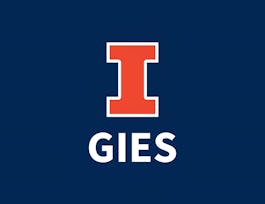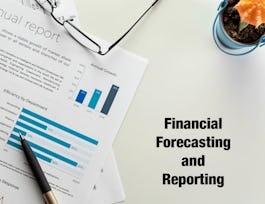This course covers the accounting for business combinations (ASC 805), the preparation of consolidated financial statements (ASC 810), and other related topics including, but not limited to: step-by-step acquisition, deconsolidation, segments reporting, and the goodwill impairment test. This course begins with a discussion of the scope of ASC 805 and the differences between business combinations and asset acquisitions. Next, the course explores the measurement and recognition principles of the acquisition method to account for business combinations. Then, the course covers the consolidation process. You will learn how to prepare the consolidated financial statements and make all of the necessary consolidation adjustments.



Advanced Financial Reporting: Accounting for Business Combinations and Preparation of Consolidated Financial Statements

Instructor: Michael Kustanovich, CPA
Sponsored by Coursera Learning Team
23,609 already enrolled
(197 reviews)
What you'll learn
Distinguish between business combinations and asset acquisition transactions.
Calculate goodwill or gain from bargain purchase on the acquisition date.
Distinguish between taxable and nontaxable assets separately from goodwill on the acquisition date.
Use the acquisition method to account for business combinations and understand its recognition and measurement principles.
Skills you'll gain
Details to know

Add to your LinkedIn profile
43 assignments
See how employees at top companies are mastering in-demand skills


Earn a career certificate
Add this credential to your LinkedIn profile, resume, or CV
Share it on social media and in your performance review

There are 9 modules in this course
You will become familiar with the course, your instructor and your classmates, and our learning environment. This orientation will also help you obtain the technical skills required to navigate and be successful in this course.
What's included
3 videos4 readings1 assignment1 discussion prompt
In this module, you will be introduced to the concepts of control over a business. You will learn different accounting methods used to account for investments in equity securities, the basics of control, the scope of "Business Combination" (ACS 805), as well as the methods to record an acquisition of a group under asset acquisition and business combination.
What's included
5 videos1 reading5 assignments
In this module, you will be introduced to the acquisition method of accounting for a business combination. You will learn the measurement principles for an acquisition and the goodwill equation to calculate the goodwill or gain from a bargain purchase as a result of the business combination. You will also learn how to prepare the consolidated financial statements on the business combination date.
What's included
4 videos1 reading4 assignments
In this module, you will be introduced to different components of consideration transferred in a business combination. You will learn the measurement principles of share-based payment awards and will examine a real-life merger between Express Scripts and Medco companies. Moreover, you will be introduced to the concept of contingent consideration and learn the methods to classify, recognize, and record contingent considerations.
What's included
4 videos1 reading3 assignments
In this module, you will gain a deeper understanding of the assets acquired and the liabilities assumed in a business combination. You will be introduced to different types of identifiable assets acquired, such as defensive intangible assets and in-process research and development (IPR&D), and the rules to recognize and measure them under U.S. GAAP and IFRS. You will also learn the difference between a taxable transaction and a non-taxable transaction and how to calculate deferred taxes on an acquisition date.
What's included
5 videos1 reading5 assignments
In this module, you will learn how to prepare the consolidated financial statements after the acquisition date. The concept of accounting acquisition premium (AAP), and the methods to calculate identifiable and unidentifiable portions of the accounting acquisition premium will be introduced. You will also learn the effects of accounting acquisition premium on the consolidated financial statements and the relevant consolidation adjustments. Moreover, you will be introduced to intercompany inventory transactions and learn to make consolidation adjustments for intercompany inventory sales and intercompany inventory profits.
What's included
5 videos1 reading5 assignments
In this module, you will be introduced to more types of intercompany transactions as well as noncontrolling interests. You will learn the consolidation adjustments for intercompany transactions with depreciable assets and intercompany debt. The noncontrolling interest (NCI) will be introduced. You will learn the definition, calculation, and presentation of noncontrolling interest and net income attributable to NCI in the consolidated financial statements. You will also learn how to report consolidated retained earnings and the subsequent measurement of noncontrolling interests. Lastly, an example of consolidation with noncontrolling interest will be shown.
What's included
6 videos1 reading7 assignments
In this module, we will explore the accounting rules for changes in the percentage of ownership of a Subsidiary and other topics that relate to business combinations. You will learn how to account for a business combination that was achieved in stages, and how to calculate the gain or loss on deconsolidation of the Subsidiary. Also, you will be introduced to the situation in which the Subsidiary acquires shares of the Parent and learn the methods to measure and record the transaction.
What's included
5 videos1 reading5 assignments
In this module, you will be introduced to segment reporting and the goodwill impairment test. You will learn the rules for public companies to disclose segment information in the notes to annual and interim financial statements. You will also learn what information should be presented in the entity-wide disclosures and when. Then, the methods for identifying the reporting units, qualitative assessment for goodwill impairment, and the quantitative one-step goodwill impairment test will be introduced. You will also learn the goodwill impairment test under IFRS and the rules for private companies to account for goodwill.
What's included
7 videos3 readings8 assignments1 plugin
Instructor

Offered by
Why people choose Coursera for their career




Learner reviews
197 reviews
- 5 stars
78.17%
- 4 stars
17.76%
- 3 stars
1.52%
- 2 stars
1.01%
- 1 star
1.52%
Showing 3 of 197
Reviewed on Nov 28, 2020
Thank you for everything. I will utilize the knowledge that I get from this course.
Reviewed on Jun 14, 2021
Very helpful for beginners and lot of interesting being covered and gained a lot of knowledge through this course
Reviewed on Aug 9, 2021
excellent course a very good for beginner, gained a lot of knowledge
Recommended if you're interested in Business

University of Illinois Urbana-Champaign

University of Colorado Boulder

University of Illinois Urbana-Champaign

University of Illinois Urbana-Champaign

Open new doors with Coursera Plus
Unlimited access to 10,000+ world-class courses, hands-on projects, and job-ready certificate programs - all included in your subscription
Advance your career with an online degree
Earn a degree from world-class universities - 100% online
Join over 3,400 global companies that choose Coursera for Business
Upskill your employees to excel in the digital economy


